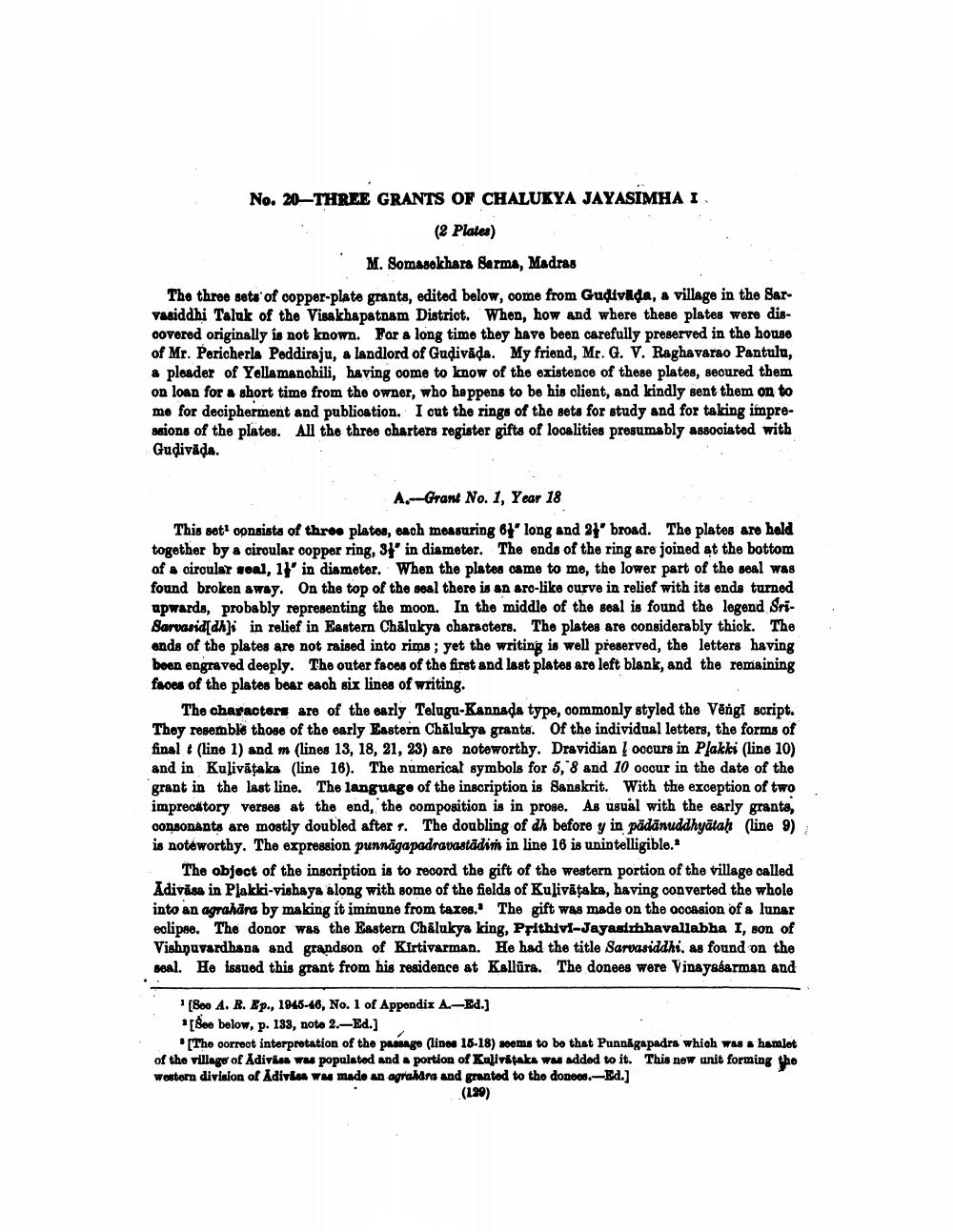________________
No. 20—THREE GRANTS OF CHALUKYA JAYASIMHA I
(2 Plates)
M. Somasokhara Sarma, Madras The three sets of copper-plate grants, edited below, come from Gudivada, a village in the Sarvasiddhi Taluk of the Visakhapatnam District. When, how and where these plates were discovered originally is not known. For a long time they have been carefully preserved in the house of Mr. Pericherla Peddiraju, a landlord of Gudivada. My friend, Mr. G. V. Raghavarao Pantulu, a pleader of Yellamanohili, having come to know of the existence of these plates, secured them on loan for a short time from the owner, who happens to be his client, and kindly sent them on to mo for decipherment and publication. I cut the rings of the sets for study and for taking impressions of the plates. All the three charters register gifts of localities presumably associated with Gudivada.
A.-Grant No. 1, Year 18 This sett opnsists of thro. plates, each measuring 61' long and 31' broad. The plates are held together by a circular copper ring, 31" in diameter. The ends of the ring are joined at the bottom of a circular soal, 1) in diameter. When the plates came to me, the lower part of the seal was found broken away. On the top of the seal there is an aro-like curve in relief with its ends turned upwards, probably representing the moon. In the middle of the seal is found the legend SriSarvasid[dhi in relief in Eastern Chalukya characters. The plates are considerably thick. The ands of the plates are not raised into rims; yet the writing is well preserved, the letters having been engraved deeply. The outer faces of the first and last plates are left blank, and the remaining faces of the plates bear each six lines of writing.
The characters are of the early Telugu-Kannada type, commonly styled the Vērgi script. They resemble those of the early Eastern Chalukya grants. Of the individual letters, the forms of final + (line 1) and m (lines 13, 18, 21, 23) are noteworthy. Dravidian oocurs in Plakki (line 10) and in Kulivātaka (line 16). The numerical symbols for 5, 8 and 10 ooour in the date of the grant in the last line. The language of the inscription is Sanskrit. With the exception of two impreostory verses at the end, the composition is in prose. As usual with the early grante. consonants are mostly doubled after 1. The doubling of dh before y in pădānuddhyātah (line 9) is noteworthy. The expression punnāgapadravastādim in line 16 is unintelligible.
The object of the insoription is to record the gift of the western portion of the village called Adivass in Plakki-vishaya along with some of the fields of Kulivitaka, having converted the whole into an agrahara by making it immune from taxes.' The gift was made on the occasion of a lunar eclipse. The donor was the Eastern Chalukya king, Prithivi-Jayasrhhavallabha I, son of Vishnuvardhans and grandson of Kirtivarman. He had the title Sarvasiddhi, as found on the soal. He issued this grant from his residence at Kallura. The donees were Vinayasarman and
[800 A. R. Ep., 1945-48, No. 1 of Appondix A.-Ed.) [See below, p. 133, noto 2.-Ed.]
[The correct interpretation of the passage (line 18-18) seems to be that Punnagapadra which was a hamlet of the village of Adivasa wu populated and a portion of Kallvitaka ww added to it. This new unit forming the western division of Adivion wm made an agradna and granted to the doneos.-Ed.]
(120)




